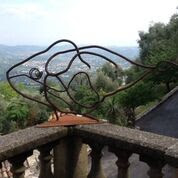Sue wrote:
Dear Santa Claus, please may I have a GPS for Christmas then I won’t have to do four U-turns in one day ! Or should I write to the Department of Roads and Bridges in Paris and ask for road signs to be sited before roundabouts and not two hundred yards down the road to the motorway!
Dear Santa Claus, please may I have a GPS for Christmas then I won’t have to do four U-turns in one day ! Or should I write to the Department of Roads and Bridges in Paris and ask for road signs to be sited before roundabouts and not two hundred yards down the road to the motorway!
Yes, we were out and
about on a garden visit in France !
In the morning we made
a return visit to Villa Fort France (“Fort” being an abbreviation of Fortescue,
and “France” the shortened version of Francoise – two previous owners) not far
from Grasse.
Sir John and Lady Fortescue bought the house in 1931, made alterations, adding the tower, and Lady Fortescue wrote her seven books at the house – the first of which was an earlier version of Peter Mayle’s description of the provençal way of life.
Sir John and Lady Fortescue bought the house in 1931, made alterations, adding the tower, and Lady Fortescue wrote her seven books at the house – the first of which was an earlier version of Peter Mayle’s description of the provençal way of life.
The garden (5,600
sq.m. but seemed at least twice the size) was already sculpted in agricultural
terraces with olive trees and vines and it was Lady Fortescue who created the
rose garden on the same level as the house.
Another previous owner was a pharmacist and it was she who planted the rare botanical species but since 1992 the de Courcels have hugely extended the planting and added a watering system. [The risers for the sprayers are cleverly concealed vertically in old terracotta drainpipes found in architectural salvage yards].
Another previous owner was a pharmacist and it was she who planted the rare botanical species but since 1992 the de Courcels have hugely extended the planting and added a watering system. [The risers for the sprayers are cleverly concealed vertically in old terracotta drainpipes found in architectural salvage yards].
The garden is a blend
of Provence and an English garden:
Provence is represented in the narrow restanques rising from the road up
to the house with their skeleton of olive trees, cypress and palm trees. The English influence comes from the roses
climbing up the stone restanque walls and the romantic underplanting either
side of the central paths in dense mixture of shrubs and perennials
interspersed with white Iceberg roses.
The ancient olive trees are heavily pruned every two years to let in
light to the luscious floral ground cover planting. Most of the plants have been grown from seed
and then allowed to self-seed; all the
box hedging has been grown from cuttings.
Our horticultural expert was not with us for the visit so the technical information will be sparse with this report! An unusual adornment of a stone wall was the almost black succulents
Aeonium atropurpureum
La Mouissone
In the afternoon we visited Lady Lockett’s La Mouissone further up the hill from Villa Fort France. This is on a much larger scale not only in terms of land (3 hectares with 250 productive olive trees) but in terms of workforce. Two full-time gardeners are supplemented by interns with horticultural theory under their belt and seeking the experience of working in a challenging atmosphere. Interns are given the opportunity to devise plantings for new areas and talk through their ideas with Lady Lockett who is an unusual mix of plantswoman and landscape designer - a recent resiting of blue Agapanthus resulted in two or three dense plantings on sloping ledges close to a rock cliff.
We struck lucky and were able to watch the head gardener giving a hugely tall cypress its annual haircut. He was attached to a high point of the trunk with the usual harness and balanced on an aluminium ladder, stepping off with one foot to work in wide upward sweeps with an electric chainsaw (lighter than the petrol version). He estimated it took him a day to trim each tree – there are four on the property.
Outside the house front
door was an interesting example of the “alternative” box hedging parterre in
rosemary. The rosemary was not planted
in a straight line but with alternate plants slightly forward; it is then trimmed with hand shears to form
a vertical scalloped edging.with a flat
top. The rosemary was planted two years
ago and quite close together so it will be interesting to see if the scalloping
can be controlled given the exhuberant form of rosemary.













